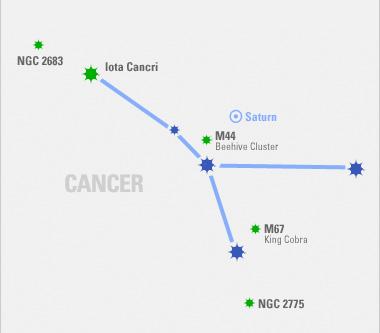

Lying quietly between Gemini and Leo, Cancer is not the most exciting of constellations. Nonetheless, it holds some modest riches worth checking out.
M44, the Beehive Cluster, is a great target for your binoculars or finderscope. More magnification than that and you'll loose the lovely sense of loose structure. Can you spot it naked eye? This month, M44 is easier to locate by eye, thanks to the presence of Saturn, shining a little to the West at Mag 0.
Even from your back yard 2,500 lightyears away, you should be able to scoop up M67 in your finderscope or binos. The individual stars of this Mag 6 open cluster will resolve nicely in your telescope's eyepiece.
NGC 2775 is a bright spiral galaxy whose core is visible in 8" scopes. Larger scopes will show hints of its spiral-arm structure. Spiral galaxies are the most common kind of galaxy, making up four fifths of all galaxy types, including our own galaxy, the Milky Way. And close by are two more galaxies, NGC 2777, a true gravitational companion of 2775, and NGC 2773 which is four times farther away from us but happens to lie along the same line of sight; you'll need a 10" scope to spot either.
At the opposite end of Cancer, Iota Cancri is a nice orange/green double star and well placed to point you just over Cancer's constellation boundary, into Lynx, where the edge-on 10th Mag galaxy NGC 2683 sits.
March 2006















